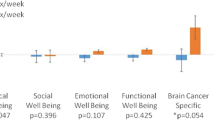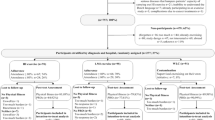Abstract
Purpose
Exercise has numerous benefits for cancer survivors, but very limited research to date has exclusively examined brain cancer patients, specifically those diagnosed with high-grade glioma (HGG). This study examined (1) the feasibility of recruiting HGG patients to an exercise-based study and performing fitness assessments; (2) exercise counseling and programming preferences; and (3) associations between fitness, physical activity (PA), and quality of life (QOL).
Methods
Participants completed assessments prior to starting Temozolamide chemotherapy with radiation (T1), at 2 months and 8 months. Fitness was measured with an incremental cycling exercise test to volitional exhaustion (VO2peak) and hand grip dynamometry. The Godin leisure time questionnaire measured PA and the functional assessment for cancer therapy, brain cancer module (FACT-Br) measured QOL.
Results
Of the 35 approached, N = 16 participated. Due to safety concerns, the aerobic fitness test protocol was altered. Participants preferred to exercise during treatment, alone and unsupervised, at home, and at a moderate intensity. Few participants (<25%) met guidelines for PA at any time point. At T1, aerobic capacity was associated with the FACT Trial Outcome Index (TOI) (r = 0.619, p < 0.05). At 2 months, PA minutes were associated with FACT-TOI (r = 0.653, p = 0.057), FACT-G (r = 0.711, p < 0.05), and FACT-Br scores (r = 0.722, p < 0.05).
Conclusions
Recruitment rate was similar to a previous study in HGG populations, but study completion rate was lower. Most exercise counseling and programming preferences were similar to previous brain cancer patients. Assessing aerobic fitness to VO2peak was not feasible. Aerobic fitness and PA were positively associated with QOL.

Similar content being viewed by others
References
Capozzi LC, Boldt KR, Easaw J, Bultz B, Culos-Reed SN (2015) Evaluating a 12-week exercise program for brain cancer patients Psychooncology
Chicco AJ, Schneider CM, Hayward R (2006) Exercise training attenuates acute doxorubicin-induced cardiac dysfunction. J Cardiovasc Pharmacol 47:182–189
Cormie P, Nowak AK, Chambers SK, Galvao DA, Newton RU (2015) The potential role of exercise in neuro-oncology. Front Oncol 5:85
Courneya KS, Segal RJ, Mackey JR, Gelmon K, Reid RD, Friedenreich CM, Ladha AB, Proulx C, Vallance JK, Lane K, Yasui Y, McKenzie DC (2007) Effects of aerobic and resistance exercise in breast cancer patients receiving adjuvant chemotherapy: a multicenter randomized controlled trial. J Clin Oncol 25:4396–4404
Field A (2013) Discovering statistics using IBM SPSS statistics. SAGE, Thousand Oaks, California
Godin G, Shephard RJ (1985) A simple method to assess exercise behavior in the community. Can J Appl Sport Sci 10:141–146
Holmes MD, Chen WY, Feskanich D, Kroenke CH, Colditz GA (2005) Physical activity and survival after breast cancer diagnosis. JAMA 293:2479–2486
Jacobs DR Jr, Ainsworth BE, Hartman TJ, Leon AS (1993) A simultaneous evaluation of 10 commonly used physical activity questionnaires. Med Sci Sports Exerc 25:81–91
Jones LW, Courneya KS (2002) Exercise counseling and programming preferences of cancer survivors. Cancer Pract 10:208–215
Jones LW, Eves ND, Mackey JR, Peddle CJ, Haykowsky M, Joy AA, Courneya KS, Tankel K, Spratlin J, Reiman T (2007) Safety and feasibility of cardiopulmonary exercise testing in patients with advanced cancer. Lung Cancer 55:225–232
Jones LW, Friedman AH, West MJ, Mabe SK, Fraser J, Kraus WE, Friedman HS, Tresch MI, Major N, Reardon DA (2010) Quantitative assessment of cardiorespiratory fitness, skeletal muscle function, and body composition in adults with primary malignant glioma. Cancer 116:695–704
Jones LW, Guill B, Keir ST, Carter BSK, Friedman HS, Bigner DD, Reardon DA (2006) Patterns of exercise across the cancer trajectory in brain tumor patients. Cancer 106:2224–2232
Jones LW, Guill B, Keir ST, Carter K, Friedman HS, Bigner DD, Reardon DA (2007) Exercise interest and preferences among patients diagnosed with primary brain cancer. Support Care Cancer 15:47–55
Jones LW, Mourtzakis M, Peters KB, Friedman AH, West MJ, Mabe SK, Kraus WE, Friedman HS, Reardon DA (2010) Changes in functional performance measures in adults undergoing chemoradiation for primary malignant glioma: a feasibility study. Oncologist 15:636–647
Jones LW, Watson D, Herndon JE 2nd, Eves ND, Haithcock BE, Loewen G, Kohman L (2010) Peak oxygen consumption and long-term all-cause mortality in nonsmall cell lung cancer. Cancer 116:4825–4832
King MT, Cella D, Osoba D, Stockler M, Eton D, Thompson J, Eisenstein A (2010) Meta-analysis provides evidence-based interpretation guidelines for the clinical significance of mean differences for the FACT-G, a cancer-specific quality of life questionnaire. Patient Relat Outcome Meas 1:119–126
Levin GT, Greenwood KM, Singh F, Tsoi D, Newton RU (2015) Exercise improves physical function and mental health of brain cancer survivors: two exploratory case studies integrative cancer therapies
Meyerhardt JA, Giovannucci EL, Holmes MD, Chan AT, Chan JA, Colditz GA, Fuchs CS (2006) Physical activity and survival after colorectal cancer diagnosis. J Clin Oncol 24:3527–3534
Peters KB, West MJ, Hornsby WE, Waner E, Coan AD, McSherry F, Herndon JE 2nd, Friedman HS, Desjardins A, Jones LW (2014) Impact of health-related quality of life and fatigue on survival of recurrent high-grade glioma patients. J Neuro-Oncol 120:499–506
Ruden E, Reardon DA, Coan AD, Herndon JE 2nd, Hornsby WE, West M, Fels DR, Desjardins A, Vredenburgh JJ, Waner E, Friedman AH, Friedman HS, Peters KB, Jones LW (2011) Exercise behavior, functional capacity, and survival in adults with malignant recurrent glioma. J Clin Oncol 29:2918–2923
Schmitz KH, Courneya KS, Matthews C, Demark-Wahnefried W, Galvao DA, Pinto BM, Irwin ML, Wolin KY, Segal RJ, Lucia A, Schneider CM, von Gruenigen VE, Schwartz AL, American College of Sports M (2010) American College of Sports Medicine roundtable on exercise guidelines for cancer survivors. Med Sci Sports Exerc 42:1409–1426
Stupp R, Mason WP, van den Bent MJ, Weller M, Fisher B, Taphoorn MJ, Belanger K, Brandes AA, Marosi C, Bogdahn U, Curschmann J, Janzer RC, Ludwin SK, Gorlia T, Allgeier A, Lacombe D, Cairncross JG, Eisenhauer E, Mirimanoff RO, European Organisation for R, Treatment of Cancer Brain T, Radiotherapy G, National Cancer Institute of Canada Clinical Trials G (2005) Radiotherapy plus concomitant and adjuvant temozolomide for glioblastoma. N Engl J Med 352:987–996
Thavarajah N, Bedard G, Zhang L, Cella D, Beaumont JL, Tsao M, Barnes E, Danjoux C, Sahgal A, Soliman H, Chow E (2014) Psychometric validation of the functional assessment of cancer therapy--brain (FACT-Br) for assessing quality of life in patients with brain metastases. Support Care Cancer 22:1017–1028
Weitzner MA, Meyers CA, Gelke CK, Byrne KS, Cella DF, Levin VA (1995) The functional assessment of cancer therapy (FACT) scale. Development of a brain subscale and revalidation of the general version (FACT-G) in patients with primary brain tumors. Cancer 75:1151–1161
Yost KJ, Eton DT (2005) Combining distribution- and anchor-based approaches to determine minimally important differences: the FACIT experience. Eval Health Prof 28:172–191
Author information
Authors and Affiliations
Corresponding author
Ethics declarations
Conflicts of interest
The authors declare that they have no conflicts of interest.
Rights and permissions
About this article
Cite this article
Nicole Culos-Reed, S., Leach, H.J., Capozzi, L.C. et al. Exercise preferences and associations between fitness parameters, physical activity, and quality of life in high-grade glioma patients. Support Care Cancer 25, 1237–1246 (2017). https://doi.org/10.1007/s00520-016-3516-4
Received:
Accepted:
Published:
Issue Date:
DOI: https://doi.org/10.1007/s00520-016-3516-4




